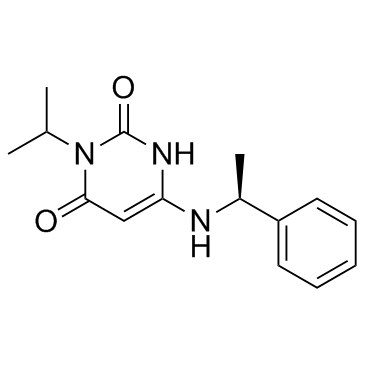| Description |
Mavacamten is a modulator of cardiac myosin, with IC50s of 490, 711 nM for bovine cardiac and human cardiac, respectively.
|
| Related Catalog |
|
| Target |
IC50: 490 nM (bovine cardiac), 711 nM (human cardiac)[1].
|
| In Vitro |
Mavacamten is found to have an IC50 value of 490 nM in the bovine system, 711 nM in the human system, and 2140 nM in the rabbit system, indicating selectivity of >4-fold for cardiac myosin[1].
|
| In Vivo |
Treatment with Mavacamten reduces FS from 52±3% to 38±7%. Treatment with Mavacamten reduces FS from 81±7% to 60±13%, corresponding to a relative reduction of 25%. Across all measurements there is a linear correlation between FS and Mavacamten plasma concentrations with each 100 ng/mL increase in Mavacamten concentration lowering FS by 4.9%. Treatment with Mavacamten eliminates SAM in 5/5 subjects, whereas SAM persists in 3/3 subjects treated with vehicle alone. Pressure gradients across the LVOT drop to 11.1±5.0 mmHg with Mavacamten treatment; whereas vehicle treated cats maintain stable LVOT pressure gradients[2]. Mavacamten reduces contractility by decreasing the adenosine triphosphatase activity of the cardiac myosin heavy chain. Chronic administration of Mavacamten suppresses the development of ventricular hypertrophy, cardiomyocyte disarray, and myocardial fibrosis and attenuates hypertrophic and profibrotic gene expression in mice harboring heterozygous human mutations in the myosin heavy chain[3].
|
| Animal Admin |
Cats[2] Five cats are selected for study. At the completion of imaging, a tenminute intravenous infusion of Mavacamten (MYK-461 (n=5)) at 0.3 mg/kg/hr IV is started. Focused echocardiography is performed after five minutes. After ten minutes, the Mavacamten infusion rate is lowered to 0.12 mg/kg/hr IV, a blood sample is drawn and an echocardiogram performed. If ventricular function remains hypercontractile or within normal limits by visual inspection, another blood sample is obtained and the Mavacamten infusion rate is increased to 0.36 mg/kg/hr IV for ten minutes. Focused echocardiography is performed after five minutes. After ten minutes, the Mavacamten infusion rate is lowered to 0.15 mg/kg/hr IV, a blood sample is drawn and an echocardiogram performed. Following imaging, the isoproterenol infusion is discontinued. When heart rate returns to baseline levels, a complete echocardiogram is performed on Mavacamten alone. Study drug is then discontinued, and animals are awakened, extubated and moved to recovery. Three of five cats are available to return for a control arm of this experiment after a 6-week washout period[2].
|
| References |
[1]. Kawas RF, et al. A small-molecule modulator of cardiac myosin acts on multiple stages of the myosin chemomechanical cycle. J Biol Chem. 2017 Oct 6;292(40):16571-16577. [2]. Stern JA, et al. A Small Molecule Inhibitor of Sarcomere Contractility Acutely Relieves Left Ventricular Outflow Tract Obstruction in Feline Hypertrophic Cardiomyopathy. PLoS One. 2016 Dec 14;11(12):e0168407. [3]. Green EM, et al. A small-molecule inhibitor of sarcomere contractility suppresses hypertrophic cardiomyopathy in mice. Science. 2016 Feb 5;351(6273):617-21.
|
